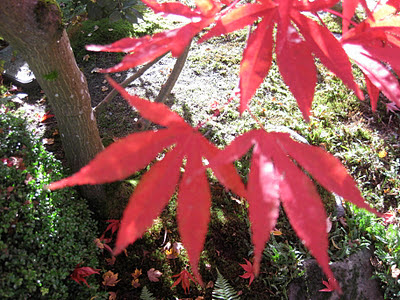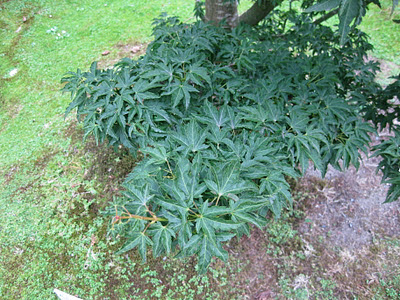by aleks
Last Saturday a team of our own docents treated us all to a delightful and delicious presentation about the nature of Japanese Holidays and Festivals from
Tsukimi (Moon Viewing Festival), through
Bunka-no-hi (Culture Day),
Gantan (New Year's day),
Kodomono-hi (Children's Day),
Tanabata ('Evening of the 7th' or Star Festival) to
Obon (Holiday commemorating one's ancestors). Perhaps one day Keiko will write a detailed post about those holidays, below just a few impressions from a grateful attendee of the presentation.
 |
Tateuchi Community Room • 11/5/11 - Continuing Education meeting:
Keiko running PPP on Japanese Holidays and Festivals |
Keiko run an overview of all holidays via power point presentation, while Shizue stepped in here and there, to demonstrate hands-on examples of games played, dolls and cards used by children and adults during different festivities. Sue did a sub-presentation on '3 friends of winter' (pine, bamboo and plum) and their role in holiday spirit and decorations, including an example of a gate maker
kodamatsu and pictures of dishes used where (one so inclined) could find the three friends among other depicted images - all fun and games.
 |
| Obon: Chiba, Japan. 2011 |
We were also treated to a reading of Hiroko's personal memories of celebrating New Year as a child in Japan - her taking the time to record it made us all feeling much closer to a 'real thing' than any official documentary on the topic would do (link to Hiroko's memories below).
 |
| TCR • 11/5/11- Learning about hagoita, for a game of hanetsuki. |
It was a very lively continuing education meeting, filled with many questions, laughter and sharing - of the many hands-on articles I personally had fun with the English version of 'One hundred poems from the Japanese', translated by Kenneth Roxtroth. This venerable looking volume, filled with poems as old as 7th century, surprised me with the intensity and sensibility of those short verses; I instantly wanted to engross myself in the collection of quite often powerful poems, but with wondrous happenings around me in real life I had to postpone it for a future trip to library.
Here a a few offerings from the volume + more on
Rexroth archive webpage:
I have always known
That at last I would
Take this road, but yesterday
I did not know that it would be today.
- NARIHIRA (9th century)
That spring night I spent
Pillowed on your arm
Never really happened
Except in a dream.
Unfortunately I am
Talked about anyway.
- LADY SUWO (11th-12th century)
 |
| TCR • 11/5/11 - Delicious Japanese food Shizue-san kindly shared with us |
The meeting ended with food offering: Shizue brought a dazzling variety of Japanese food - a rice dish called
chirashi-zushi, daikon and carrot salad
Namasu, tofu, beans and different veggies, all neatly packed in traditional stackable lacquered boxes, while Keiko prepared and presented in a crock-pot amazing amazake - warm and sweet fermented rice wine with close to zero alcohol content - I found a
recipe here, but it looks very involved, perhaps Keiko can share her own recipe. After many years of having cold amazake (PCC co-op sells it in refrigerator section), I learned that it's supposed to be served warm, and it was way more delicious that way. And certainly cold amazake is not as bad as cold pierogis: once in the past I designed a Polish-style dinner, which was prepared without my supervision in someone else's house + my instruction were probably not clear, because later I was told that the appetizer was particularly gross: the poor pierogi dumplings were served cold before dinner, instead of being a main hot entry.
THANK YOU! our Continuing Education Committee and the last Saturday Presenters for this truly memorable teachings - we are lucky to have such an interesting group of people working as a TEAM to educate the rest of us.
• Link to the lecture's handout containing a
list of all holidays
• Link to Hiroko's memories of her
childhood New Years celebrations in Japan
Below some additional outstanding links courtesy of Keiko-san, who helped me tremendously in researching this little report by patiently providing her time and expertise, sharing many explanations, web-resources, Obon photograph, as well as a lively discussion on the art of translating Japanese poetry... Thank you, Keiko-san for all the assistance and enjoyment you gifted me with and that went into making this post!
•
MacCauley's translation of Hyakunin-isshu from University of Virginia Library
•
Sketches of Japanese Manners and Customs (1867) by J. M. W. Silver. (The Project Gutenberg eBook)
•
Japanese Irises by the Japan Iris Society
•
Free desktop wallpaper (shichi-go-san)



































